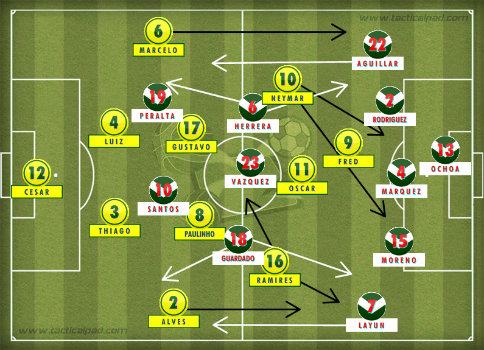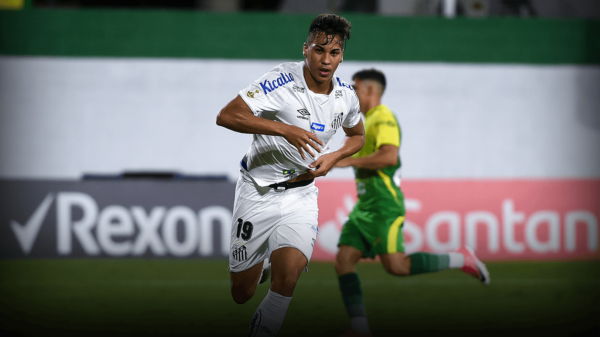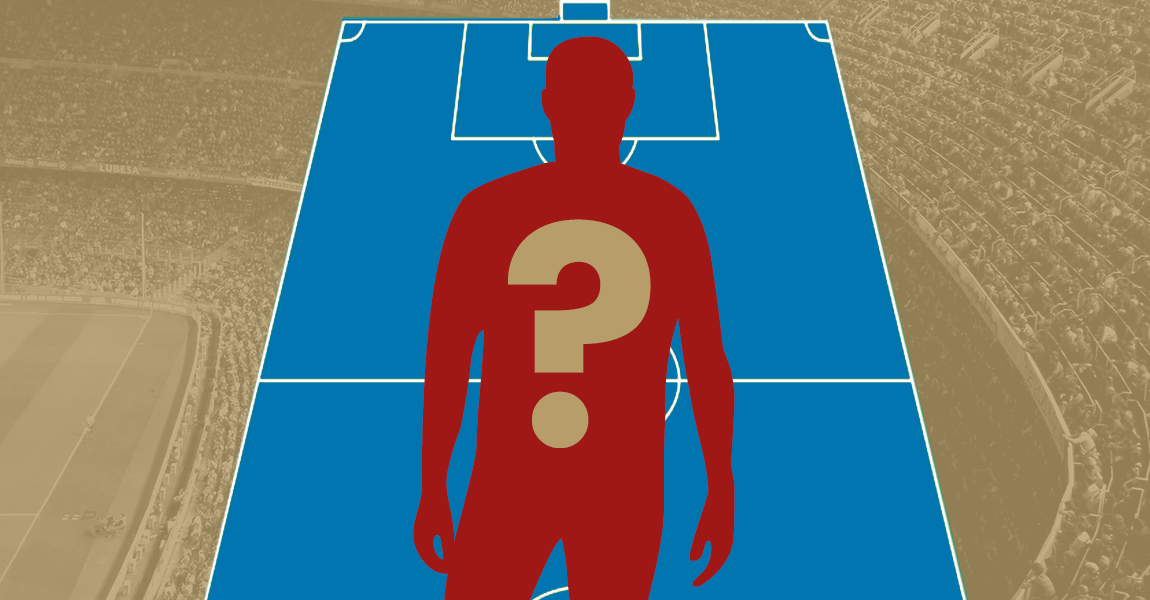With three points and the prospect of leading the group in sight, both teams set up with nothing held back. In a group stage game where Brazil failed to score for the first time in 36 years, the Mexicans showed great resistance in keeping Brazil at bay.
FORMATION & LINE-UPS
Just one change was made from the Brazil line-up involved in the victory over Croatia, with Ramires in for Hulk. No changes for the Mexicans, as they opted to start with the same line- up that snatched a 1-0 win over Cameroon.
Brazil (4-2-3-1): Cesar, Alves, Silva, Luiz, Marcelo, Gustavo, Paolinho, Ramires (Bernard, 45’), Oscar (Willian, 83’), Neymar, Fred (Jo’, 67’).
Mexico (5-3-2): Ochoa, Aguilar, Rodriguez, Marquez, Moreno, Layun, Herrera (Fabian, 76’), Vazquez, Guardado, dos Santos (Jiminez, 83’), Peralta (Chicharito, 72’).

ANALYSIS
Brazilian attacks moving wide
Most Brazilian attacks moved outward in the final third of the pitch. In most circumstances the widening begun in their own defensive half. The Brazil full backs had more touches than anyone else on the pitch. Constant centre-back pressing from the two Mexican forwards forced the ball to the full-backs. Both Brazilian fullbacks, being efficient in running with the ball, moved the ball along the lines to wider areas of the pitch.
Oscar was seen using his roaming/floating role to pop into wider areas rather than operating in the hole. Ramires and Paulinho also opted in shifting to wider areas of the pitch as play progressed.
Neymar constantly moved attacks centrally for Brazil, where they did seem to be a threat.
The wide focus may also explain why Vazquez had a comparatively quiet day defensively, in midfield.
Wide play from the Brazilians was negated more than often by Mexico (those that weren’t were negated by Ochoa).
A five man primary defensive structure allows for more defensive width without the loss of shape. Constant support from Guardado and Herrera provided cover for Mexican wing-back overlap, and also checked offensive runs made by the Brazilian full-backs.
Provided the wing-backs were properly positioned, the three Mexican centre-backs were adequate to fend off most deliveries from out wide.
Lack of involvement of strikers
The (tactically) proper strikers were involved in very few relevant offensive incidents in the game.
Fred was ineffective for the Brazilian attacking cause. His lack of involvement has a lot to do with the fact that most of Brazil’s attacks were subsided out wide by Mexican defenders, and the Mexican box was marked by 3 well-oriented centre-backs during every delivery.
MORE READING
Also, with Oscar roaming in wider areas, the only source of central link-up for the striker was unavailable through the major course of the match. Neymar’s inward diagonal runs held certain promises, but were still inconclusive.
Mexican strikers Peralta and Giovanni dos Santos also struggled in pursuit of having any major impact. Apart from a few quick exchanges in link-up between the two, neither looked as promising as in the first game.
Luiz and Silva had a major part in this negation. The Strikers struggled to find space behind the pair. However, Chicharito’s entry seemed to stretch the pair to a certain extent, with the striker working to find space and with frequent success.
(All three strikers that started were substituted through the course of the game.)
A game of spaces
Tactical neutralization between the two teams can be attributed to the way both teams handled spaces on the pitch.
Brazilian tactics had its focus on players running with the ball into space. The Mexican defensive tactics involved negating playable voids on their half of the pitch more than anything else.
With Guardado and Herrera also defending in wider areas, wide spaces were easily covered, along with the wing-back and a centre-back. The only viable wide-space seemed to be behind the wing-backs, but a tactically-resound display from Aguilar and Layun didn’t seem to favor the Brazilian cause.
Formational compression from the Mexican defense even left very little space (here, centrally) on the counter.
The correlates of spaces and speed of play were also shown. Initial Brazilian play was slow, leaving lesser space to play in. The advent of Willian and Bernard alongside Neymar, Marcelo and Alves in the later stages of the game, upped the pace of play, creating more space, and aggravating the threat of their attack.
The Mexicans opted to stretch the play in the opposition half with constant wing-back overlap and wide CM support. Not surprisingly, Aguilar, Layun, Guardado and Herrera were more involved than any other Mexican player by some extent.
Stretching of play drew out fullbacks. The CBs had to handle the two strikers, which left them with very little room for deviation. This created space at the edge of the box. Mexico opted to use this space for direct attempts rather than play in it. Although promising, the attempts proved ineffective.
KEY PLAYER OF THE MATCH
A scoreless draw is usually an indication for a man between the posts to have performed exceptionally, and the edge does bend towards the Mexican man in gloves, who swiped clean all the chances that leaked past the Mexican defense. His performance deserves it’s due credit.
However, on a strict basis of tactical performance, the skipper Marquez seems the appropriate choice. From organizing his defense to performing his individual defensive role, his role was vital in the Mexican defensive set-up that grabbed a clean sheet and a point from the hands of Brazil.
Efficient tackles and some well-though interceptions in the defensive third encased the years of experience with the national squad. His occasional advent out of the defensive line to mark the man roaming in the opposition hole-area proved vital in stopping central play, and was a source of some vital interceptions.
WHERE DOES THIS LEAVE THEM?
With the teams tied at four points, the result obviously bears more promise for the Mexican side. The result will bear a psychological impact on the players in their next game against Croatia. A sound tactical display will only credit their cause of knock-out stage qualification. Ochoa’s performances seems to have instilled a sense of confidence among the Mexican side, but any other day, those few defensive lapses could have proven costly.
Brazil will want to qualify to the next round as group leaders, and need to get a result in their last group game against Cameroon.
The performance may also be taken as a call for Scolari and his men to lift the immense pressure of Neymar’s shoulder for a game, and test newer creative options alongside Oscar.
Read all our World Cup content here
- Premier League: The Growing Trend Of Counter-Attacking Goals - June 11, 2020
- Analysis | Three Things We Learned: NorthEast United 0-1 Bengaluru FC - December 9, 2017
- Three Things We Learned: NorthEast United 0-0 Jamshedpur - November 19, 2017




























































